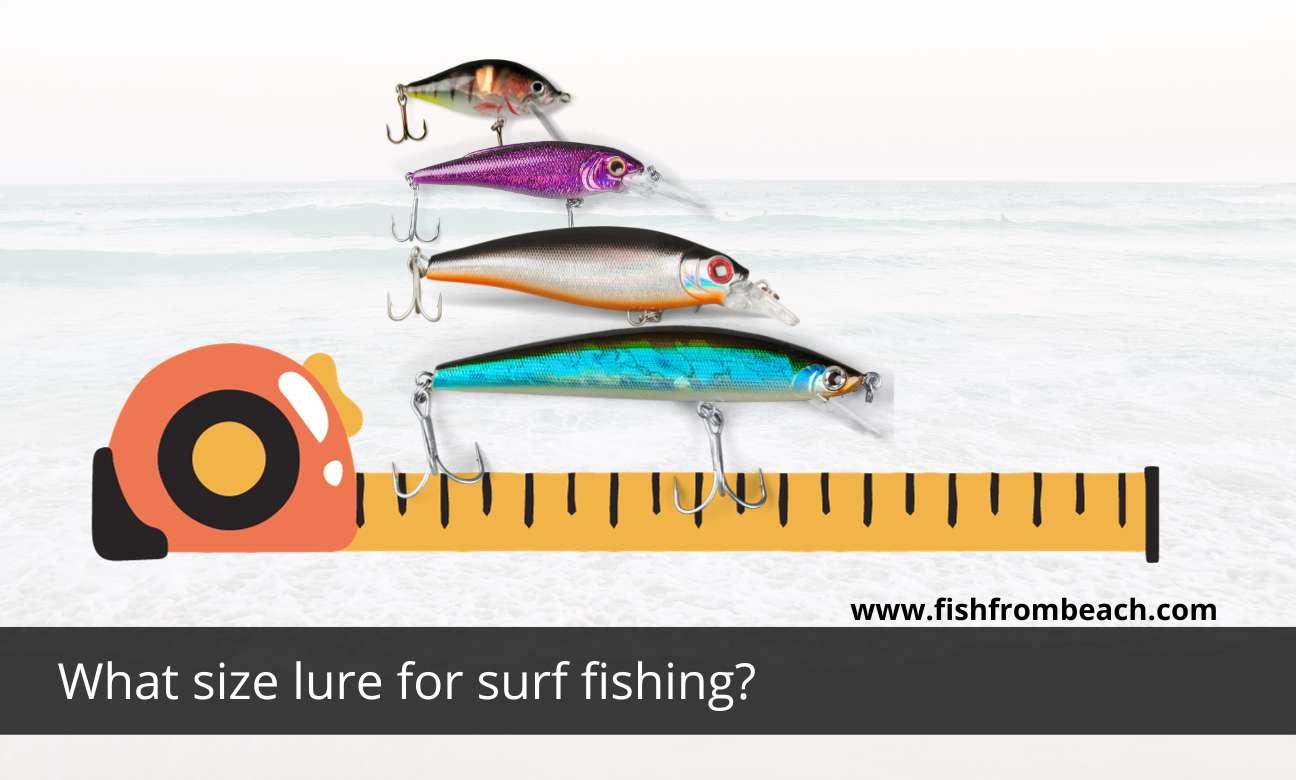When it comes to selecting a lure for surf fishing, size often claims to be an important variable.
Indeed, a frequent question I come across on discussion forums and Facebook groups is, “What size lure to choose for surf fishing?”
That’s what we will discuss today.
In this article, we will explore the various factors that influence the size of your lure when beach fishing and provide insights into the considerations to keep in mind when determining the length of your surf lure.
So without further ado, let’s start by answering the question.
Your lure should always be the same size as the baitfish you are trying to mimic. Considering that most baitfish species reach their maximum size in late summer or fall, the best lure size for surf fishing is 3-4 inches in winter and spring and 5-6 inches in summer and fall.

What dictates your size lure when surf fishing?
The main factor that dictates your lure size when surf fishing is the baitfish species available in your area. As a rule of thumb, your lure should be the same size as the average baitfish within your casting range.
That’s what predators are feeding on, and therefore that’s how your lure should look like.
For example, if there are schools of mullet where you cast the line with an average mullet size of 4 inches, then your lure should be 4 inches too.
Okay, but if there are thousands of mullets where I fish, wouldn’t using a bigger lure be a smart thing to do? I mean, in order to stand out and make my offer more visible?
No. Changing the size of your lure should never be your solution to stand out and make fish notice your lure.
In fact, throwing a lure that is either bigger or smaller than the average baitfish’s size can spook or intimidate the fish, making them more hesitant to strike.
If you want to stand out, the best thing to do is to experiment with different retrieval techniques until you get the bite action you desire.
Another tip to trigger more bites when lure fishing is to use lures with a red, orange, or pink spot on them. These colors give your lure the look of a wounded or dying fish, which encourages predators to strike.
I mean, even if you cast a lure that is the same size as available baitfish, by simply introducing shades of red, pink, or orange to your offer, game fish are likely to ignore the whole school and focus only on your lure because it appears as the weakest one.
We have covered more tips like this in our ebook “101 tips for surf fishing“. This guide will answer all your surf fishing questions and spare you 2-3 years of research, experimentation, and trial and error. Make sure to give it a look.
How to decide on lure size when surf fishing?
As we said, the key is to observe the size of available baitfish and try to match that with your lure.
Note here that fish underwater may appear slightly larger than they actually are, so consider cutting half an inch when selecting your lure.
Now, if you can’t find any baitfish population within your casting range, then it’s time for some guesswork.
The key factor here is the season.
Generally, baitfish are smaller in winter and spring and larger in summer and fall.
This is the case for mullets which migrate to inshore waters in spring, where they become juveniles with an average length of 2.5 inches (50 mm). Subsequently, they continue to grow and reach lengths of 6-7 inches by fall.
The same applies to anchovies. After hatching in offshore waters between October and March, they migrate to inshore waters and undergo rapid growth, increasing from 2-3 inches to 4-5 inches during spring, summer, and fall.
Similarly, herring spawns in March, and the juveniles grow from 2 inches up to 4-5 inches in the next few months.
So as you can, typical surf fishing baitfish grow in size as the season changes from winter to fall.
Therefore, your lure selection should also match this pattern by opting for small lures in winter and larger ones in late summer and fall.
As general guidelines, your lure size for surf fishing should be as follows:
- 2-3 inches in late fall, winter, and early spring
- 3-4 inches in late spring
- 4-5 inches in summer
- 5-6 inches in early fall
Again, these are general guidelines. It’s necessary to consider the type and size of baitfish available in your area before you make any choice.
Asking fellow fishermen, local tackle providers, and bait shops can be very helpful here.
Also, do not hesitate to use larger lures if you notice large baitfish in the surf zone.
For instance, the mullet run during fall often brings mullets in the size of 7-9 inches. If you see a lot of these, don’t hesitate to opt for 7-9 inches lures.
Last word
Yes, the size of your lure matters a lot when beach fishing. However, it’s advisable not to switch up lures too often just because you think the lack of bites is due to the wrong lure size.
After applying the guidelines we discussed in this article and deciding on a lure, I would pay more attention to the retrieve technique and pattern than to my lure size selection.
Most of the time, a tiny tweak in the way I retrieve the lure yields a huge impact on my bite count.
So in summary, pick a lure of the same size as the baitfish in your area, then start experimenting with different retrieve techniques and patterns. If you experience a very low bite action, don’t automatically blame the size.
Note (*): If you make a purchase through links from this website, we may get a small share of the sale from Amazon or other similar affiliate programs.
Surf Fishing Survey
Help us provide you with better content by answering simple questions about your surf fishing experience and knowledge.
We will put the collected responses together and turn them into valuable information that will help you catch more fish from shore 😉
Note: No personal information will be collected with your answer.

